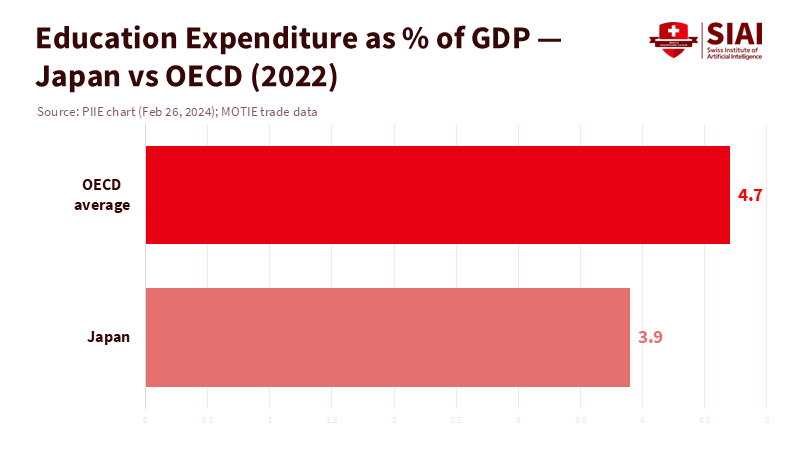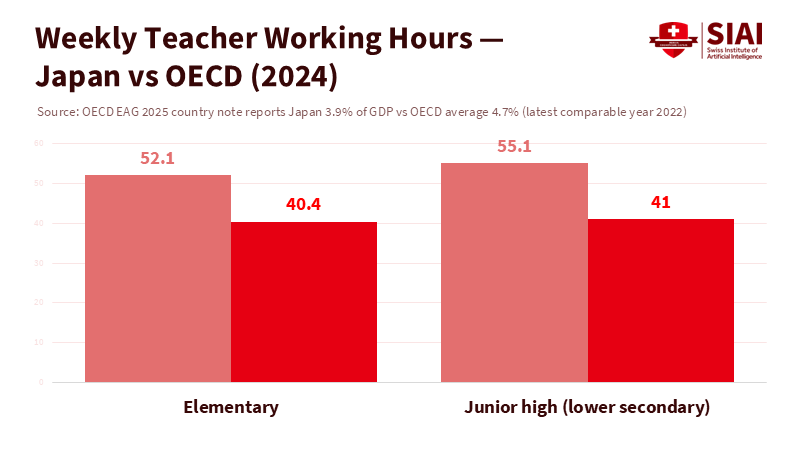The Rational Gamble: Takaichi’s Rise and the Hard Reset for Japan's Education Policy
Input
Modified
Takaichi’s rise is a pragmatic bet, not a protest vote Shrinking cohorts demand an education reset—protect funding, cut teacher overload, use AI with guardrails Judge success by delivery: fair consolidation and measurable gains in teacher time

Japan reached a critical point last year. Births fell below 700,000, and the total fertility rate dropped to 1.15. Both are modern records indicating a rapid decrease in the school-age population. At the same time, teachers worked some of the longest hours in the OECD, while public education spending remained below the OECD average as a share of GDP. The system is stretched thin while its student base declines. These are not distant trends; they shape the daily decisions of principals who must decide whether to merge classes, municipalities that consider closing schools, and parents who wonder if quality education will remain accessible nearby. In this context, the Liberal Democratic Party’s selection of Sanae Takaichi appears to be a rational gamble. It is an effort to gain clarity and control at a moment when Japan's education policy urgently needs a reset.
The mandate behind the moment for Japan's education policy
Party turmoil may indicate a drift, but the collapse of the longstanding LDP-Komeito coalition and the scramble that followed reflect an electorate seeking competence and coherence, not simply an ideological shift. The practical outcome is that whoever is in power will need to demonstrate early, visible results in areas that affect families most. Few sectors present a clearer opportunity than education. Here, demographic pressures have direct consequences. It is also where policy can stimulate growth without fueling inflation. In this sense, betting on Takaichi is a bet that an effective manager can set priorities and make decisions quickly. This wager will not be judged by speeches about reform, but by budgets that protect classrooms, schedules that lessen teacher workloads, and a credible plan to adjust school resources to a smaller student base while improving quality.
The immediate challenge is arithmetic, not ideology. Without Komeito, the LDP remains the largest political entity but must gather votes one law at a time or establish a new agreement to pass bills. This situation makes education both a risk and an opportunity. It is a risk because efforts to consolidate, reform workloads, and change curricula can upset key supporters. However, it also presents an opportunity, as there is widespread agreement across party lines on many educational issues, from digital learning to expanding childcare. A savvy government can present Japan's education policy as family-centered during a turbulent political time. The expectations are high: the country spends about 3.9% of GDP on education, compared to the OECD average of nearly 4.7%. Any new coalition arrangements that boost defense or industry spending will increase financial pressure unless growth picks up or taxes change.

Coalition flux and clear choices in Japan's education policy
Education will be the first test of governing skills because the facts are undeniable. Japan’s fertility rate dropped to 1.15 in 2024, and final vital statistics show births decreasing to the mid-680,000s, much lower than demographers anticipated for this decade. This decline means smaller student cohorts are not just a temporary pandemic reaction; they reflect a long-term trend that will affect primary and secondary schools and eventually universities. A realistic plan must therefore involve two actions: consolidate resources where demand is down and reinvest the savings in areas like teacher time, targeted tutoring, early education programs, and modern curricula. It should also ensure that rural and low-income communities don’t suffer disproportionately from closures.
The second decision is about timing. Japan swiftly turned the GIGA School Program into a one-to-one device initiative, faster than many countries. MEXT has now released Version 2.0 guidance for using generative AI in schools. It encourages thoughtful use, avoids one-size-fits-all bans, and emphasizes teacher training. This reflects a practical approach: using tools that improve quality, managing risks with human judgment, and building a digital assessment system. The political advantage here lies in speed with safeguards. A government that invests in training hours, safeguards planning time in schedules, and shares clear classroom pilot information can move beyond mere slogans. The actions required are not radical. They involve aligning AI guidance, assessment reform, and relief for teacher workloads into a straightforward law-and-budget program that local boards can execute without ambiguity.
A shrinking cohort demands a different approach for Japan's education policy
Japan’s schools perform well according to international standards. PISA 2022 results show scores above the OECD average in mathematics, reading, and science, with improvements in reading and science since 2018. The current challenge is to maintain quality as the system shrinks and ages. That makes teacher time a crucial issue. Recent reports indicate that elementary teachers work about 52 hours a week. In comparison, junior-high teachers clock around 55 hours—over ten hours longer than global averages. When educators spend so much time on clubs, paperwork, and supervision, they have less time for planning, feedback, and engaging with families. Reductions in workload cannot simply be announced; they require funding for non-teaching staff, stricter limits on extracurricular duties, and a scheduling system that protects collaboration time, similar to how hospitals allocate time for staff handoffs.
Funding is essential, but so is its allocation. Japan’s public education spending as a percentage of GDP trails the OECD average, even as spending per student compared to GDP per capita appears strong. This situation leads to cautious budgeting: maintain quality while the base shrinks. The more innovative approach is to adjust spending within the current framework. Invest more in early childhood and the initial years of primary school, where returns are highest. Tie digital purchases to evidence-based practices and training rather than hardware counts. Continue the 2025 expansion of high-school tuition support while targeting it better as student numbers drop and financial pressures increase. The politics become simpler if the government connects every yen saved from unused seats to tangible improvements in teacher time and student support.

Delivery, not doctrine: how to judge Japan's education policy in the Takaichi era
The main discussion will focus on identity, industrial policy, and security. However, families will evaluate this government based on five educational criteria. First, can it secure a multi-year commitment that protects core school funding even as defense expenses grow? The numbers are tight: the FY2025 budget increases defense spending, and debt already covers a large portion of general expenses. A credible commitment to classroom budgets would indicate a prioritization of long-term growth. Second, can it translate workload reforms into actual hours freed at the school level? It should publish a straightforward metric showing average weekly teacher hours and the percentage spent on teaching, preparation, and non-teaching tasks, broken down by prefecture. Third, can it provide clear, teacher-first guidelines for AI adoption? The guidelines exist; the missing element is funded time for training, peer observation, and curriculum alignment.
Fourth, can it manage school consolidation fairly? This means guaranteeing service levels for travel times, after-school programs, and specialized support when schools close. Fifth, can it keep universities engaged? As fewer 18-year-olds graduate, institutions will need to diversify offerings with adult learning, micro-credentials linked to employers, and research collaborations that benefit local economies. None of these assessments requires a revolution. They demand coordination, steady budgets, honest data, and focused administration. This is why this is a political opportunity. A government that excels in improving schools can build trust for more formidable challenges in other areas. It can also reduce long-term financial stress by increasing productivity in human capital. Voters in Italy and the United States have supported leaders who promise decisive action. Japan's interpretation of this challenge will only be validated if classrooms genuinely feel the difference.
Anticipating the critiques
Critics will argue that defense spending, industrial support, and household relief must take precedence in a fragile economy. However, this is not an either-or situation. Human capital enhances every other agenda, and delays in investment can lead to bigger costs later. Others may suggest that rapid AI adoption in schools could deepen disparities or weaken foundational skills. The solution is not to ban AI, but to design a thoughtful approach with clear guidelines, teacher-led pilots, curriculum integration, and strong assessment data. Japan's own guidance emphasizes suitable use, security, and local autonomy rather than blanket bans. This approach suits the country's already high standards of student achievement and its lesson study culture. A final critique may state that a leader vying for parliamentary votes cannot manage complex school reforms. This approach confuses cause and effect. Education is one of the few areas where broad alliances are feasible. Producing recognizable improvements in teacher time and student assistance can lead to political stability rather than being a victim of its absence.
A note on capability and expectations
Comparisons to international figures are inevitable. Some observe the will to push through unpopular reforms. In contrast, others worry about a leader who may falter due to party divisions or market anxieties. These comparisons matter less than the results that parents and teachers will monitor. If, one year from now, teachers’ weekly hours decrease, school consolidation plans are transparent and fair, AI usage is focused and effective, and high-school tuition support reaches families efficiently, the political narrative will shift. If not, it will affirm the public’s belief that politics excels at announcements but struggles with execution. The current coalition dynamics create a challenging environment, but they also make it the right time for change. The political system is adjusting; education can prove that Japan still excels at tackling complex challenges.
The core issue remains stark: fewer babies, fewer students, and a heavier burden on the adults who teach them. This is why the bet on Takaichi—regardless of one's view of her beliefs—represents a demand for action. Japan's education policy is where this urgency and accountability are most pressing. Protect classroom budgets even as other priorities grow. Restore teacher time through well-funded workload reforms. Use digital tools wisely and with proper training, rather than relying on buzzwords. Consolidate fairly, and demonstrate how every yen saved translates into more time gained and better support for students. Families will support tough decisions if they clearly see the strategy, monitor the metrics, and notice real improvements. The political atmosphere is chaotic, but the core message is clear. If this government turns demographic decline into a strategy focused on education-driven productivity, the gamble will seem wise. If it fails, voters will seek out someone who will act decisively.
The views expressed in this article are those of the author(s) and do not necessarily reflect the official position of the Swiss Institute of Artificial Intelligence (SIAI) or its affiliates.
References
Associated Press. “Citing unease over graft, Japan’s Komeito leaves the longstanding ruling coalition headed by the LDP.” 10 Oct 2025.
Channel NewsAsia. “Commentary: Is Sanae Takaichi Japan’s Margaret Thatcher or next Liz Truss?” 2025.
Financial Times. “Japan’s ruling coalition collapses in setback for new LDP leader Sanae Takaichi.” 10 Oct 2025.
Financial Times. “Japan opposition in talks to challenge Sanae Takaichi after coalition collapse.” 13 Oct 2025.
Japan Ministry of Education, Culture, Sports, Science and Technology (MEXT). Guidelines on the Use of Generative AI in Primary and Secondary Education (ver. 2.0). Dec 2024 / Apr 2025 English brief.
Japan Ministry of Education, Culture, Sports, Science and Technology (MEXT). Tuition Support for High School Students (FY2025 edition). Apr 2025.
Japan Ministry of Health, Labour and Welfare (MHLW). Summary of Vital Statistics (final data), 2024 – Rates (includes total fertility rate). Sep 2025.
Japan Ministry of Health, Labour and Welfare (MHLW). Summary of Vital Statistics (final data), 2024 – Population, Live births, Deaths. Sep 2025.
Japan Prime Minister’s Office. “Press Conference by Prime Minister Ishiba.” 1 Apr 2025.
Japan Times. “Teachers in Japan still work the longest hours, OECD survey shows.” 7 Oct 2025.
MEXT. “Improving the Quality of Education Through the GIGA School Program.” 2022 briefing.
OECD. Education at a Glance 2025: Country Profile—Japan. 2025.
OECD. PISA 2022 Results: Country Note—Japan. 5 Dec 2023.
Nippon.com. “Births in Japan Fall Below 700,000 for the First Time in 2024.” 5 Jun 2025.





















